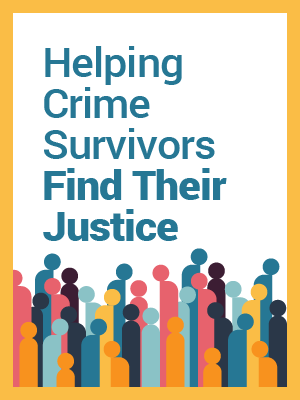Archival Notice
This is an archive page that is no longer being updated. It may contain outdated information and links may no longer function as originally intended.
Terrorism and Mass Violence
In recent years, the Nation has experienced a surge in incidents of mass violence and domestic terrorism. These tragedies have affected a range of communities—from small rural areas to large urban populations—and various locations, such as schools, workplaces, nightclubs, and public settings. As the frequency of these tragedies increases, OVC recognizes the need to become better prepared and equipped with the necessary knowledge, skills, and evidence-based strategies to appropriately plan for, respond to, and fully support victims and communities affected by mass violence.
Victims of Crime Act (VOCA) victim assistance grants served an average of 11,872 victims of mass violence and an average of 3,825 victims of terrorism per quarter. In the same timeframe, VOCA victim compensation grants paid 1,824 claims related to mass violence and 149 claims related to terrorism.
The Antiterrorism and Emergency Assistance Program (AEAP) is one of the principal tools OVC uses to provide supplemental financial assistance to local communities in the wake of tragedy. These grants are methodically developed to ensure that allowable expenses are reimbursed, and communities and victims are supported for up to several years as they recover, rebuild, and adjust to a dramatically changed way of life following domestic terrorism and mass violence incidents. For more information about AEAP and funded activities during this reporting period, visit the OVC Supports Victims of Domestic Terrorism and Mass Violence section of the report.
In FY 2017, OVC launched a new National Mass Violence Victimization Resource Center (NMVVRC) to support the comprehensive needs of victims of mass violence and domestic terrorism and assess the needs of victims of large-scale criminal incidents. In FY 2020, OVC provided $3.4 million in supplemental funding to NMVVRC to achieve maximum outreach and benefit to impacted communities and, in FY 2022, an additional $2.2 million for a needs assessment project of communities that experienced mass violence incidents. Preliminary findings from the Parkland, El Paso, and Pittsburgh needs assessment surveys found that PTSD rates are higher than the national average in communities where there has been a mass violence incident—5.5 times higher in El Paso, Texas; 5.3 times higher in Pittsburgh, Pennsylvania; and 4 times higher in Parkland, Florida. Rates are even higher for those with low social support and experiences of prior victimization.
In FY 2020, NMVVRC deployed the Transcend app, a self-help app to help victims of and responders to mass violence and terrorism incidents with psychological recovery, including strategies to reduce stress and coping activities. In FY 2022, NMVVRC was awarded nearly $750,000 through the FY 2022 Advancing the Use of Technology to Assist Victims of Crime program to develop a separate and new app (Transcend for Victims and Survivors) that will provide access to information about other types of violent crime and their unique impacts on victims, resources explaining victim services and rights, evidence-based self-help strategies, psychoeducation about effective therapeutic interventions, and links to location-based victim assistance and mental/behavioral health services while respecting victim autonomy and privacy.
In FY 2022, the NMVVRC released the Planning and Implementation Guide: Comprehensive, Coordinated Victim Assistance for Mass Violence Incident Trials, which it created with the U.S. Attorney’s Office for the District of South Carolina with funding from OVC. The guide will help prosecutors, victim services and mental/behavioral health providers, and allied professionals plan for high-profile trials with a focus on victims’ needs, survivors’ needs, and effective and coordinated strategies to meet them. Since it was published in February 2022, the guide has been downloaded 274 times by 199 users, making it the second most downloaded PDF published by NMVVRC.
In FYs 2021 and 2022, NMVVRC completed 49 requests for technical assistance; conducted 30 webinars, training programs, and other presentations about mass violence preparation, response, recovery and resilience; and responded to 14 direct requests from communities for technical assistance or consultations. During FY 2022, NMVVRC reported 60 TA recipients and 1,416 training recipients.
In FY 2020, OVC awarded nearly $3 million for the Improving Community Preparedness TTA project to help communities prepare for mass violence incidents and ensure that victims issues are considered in emergency response plans. During FYs 2021 and 2022, this TTA project—directed by ICF in partnership with the International Association of Chiefs of Police, the National Sheriffs Association, the National Compassion Fund, and the National Organization for Victim Assistance—developed their framework around 16 best practices in planning; launched their website, which hosts multiple resources and trainings including Mass Violence vs. Mass Fatality Planning and Responding to Mass Violence Involving Higher Education Institutions; conducted 18 workshops, meetings, and podcasts; and provided individualized TA to more than 12 communities.
OVC TTAC Supports First Responders to Mass Violence
Through its Training and Technical Assistance Center (TTAC), OVC provides TTA to communities across the Nation in implementing the tools and practices contained in OVC’s Helping Victims of Mass Violence and Terrorism: Planning, Response, Recovery, and Resources toolkit. The toolkit helps communities collaborate and plan for these incidents and develop more timely, effective, and comprehensive responses for victims.
For additional information, visit OVC’s website.




